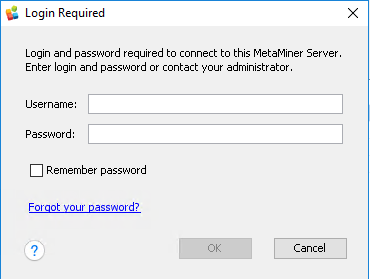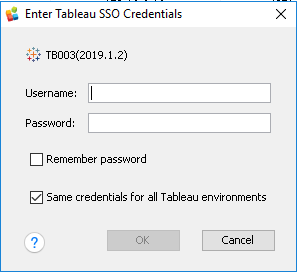Connection Manager
Connection Manager is a tool used to manage your connection to MMTE Server.
To open Connection Manager:
- Choose File – Connection Manager from the main menu, or
- Double click the server icon in Status Bar (see Monitoring Connection to MMTE Server below), or
- Press Ctrl + M, see also Keyboard Shortcuts.
The Connection Manager window opens:

When you open Connection Manager, it auto-detects MMTE Servers in your local area network by sending broadcast requests via all network interfaces of your computer on most typical TCP ports used by MMTE (see Network Configuration).
You can also force MMTE Client to re-scan your LAN by pressing the ![]() Refresh button.
Refresh button.
MMTE Client collects responses of MMTE Servers in your network, it takes some time:

When auto-detecting finishes, the list of auto-detected MMTE Server instances is displayed at the top the Connection Manager window, if there are any. Otherwise, a warning about firewalls is displayed:

To choose your MMTE Server:
-
Choose MetaMiner Server Host from the list of auto-detected instances, or specify the host manually. For this, you can enter its host name or FQDN, or IP address. Examples:
infolytikserver myserver.company.com 74.189.15.169 -
Specify MetaMiner Server Port for the connection, if it differs from the default or auto-detected value. Note that you must specify the same value that was previously entered in MMTE Administrator (see Server Section Settings).
-
Click the Connect button.
If User Defined Security is enabled, the Login Required dialog box will appear:

-
Click OK.
The Validating connection... dialog window opens.
-
Wait for the end of validation process. Results are displayed in the Connection Manager window.
If connection to MMTE Server was successful, then the Host and Port fields are displayed with green marks
 :
:
But if connection to MMTE Server failed, its name is displayed with a red icon:

-
Make sure connection to your MMTE Server is validated. The list of Tableau environments, available on the selected server, is now displayed at the bottom part of the Connection Manager window.
- You may want to skip loading of some environments by clearing the appropriate Enable checkboxes in the list to minimize the resources required by MMTE Client.
- If you want to connect to the same server and the same environments each time you start MMTE Client, and save your choice of environments, check the Reconnect on startup checkbox.
- Click Apply. Connection to the MMTE Server is established, and your configuration is saved.
-
The Enter Tableau SSO Credentials dialog box opens:

-
Specify login & password for each Tableau environment you are going to connect. Note that generally speaking these credentials are different from those specified on the previous step.
- Click OK. MMTE Client starts to load your BI data from the selected environments.
- Wait for the BI data to be loaded from MMTE Server to MMTE Client. When you connect MMTE Server to your environment for the first time, this initial pull from Tableau may take much time, and MMTE Client will not finish loading until this initial pull is finished. See also Connecting MMTE to your Tableau Software.
Finally, the main MMTE Client screen is displayed.
Monitoring Connection to MMTE Server¶
During your work with MMTE Client, you can constantly monitor status of your connection to MetaMiner Server. For this, look at the left bottom corner of the MMTE Client window, in Status Bar:

If connection to MMTE Server works fine, the server icon has a green label, as shown above.
Otherwise, the icon has a yellow warning label:

To fix problems with the connection, open Connection Manager again by clicking the server icon.
Connecting over SSL¶
There are absolutely no manoeuvres for the customers for achieving this as the MMTE Client is configured to handle this implicitly.
Here is the detailed explanation of MMTE Client SSL connection workflow.
-
MMTE Client tries to connect MMTE Server over SSL.
-
If the server is SSL enabled, then it connects successfully.
-
If the server is not SSL enabled, then it connects with MMTE Server without SSL.
So, either way SSL/Non SSL connections to MMTE Server are handled by MMTE Client effortlessly.